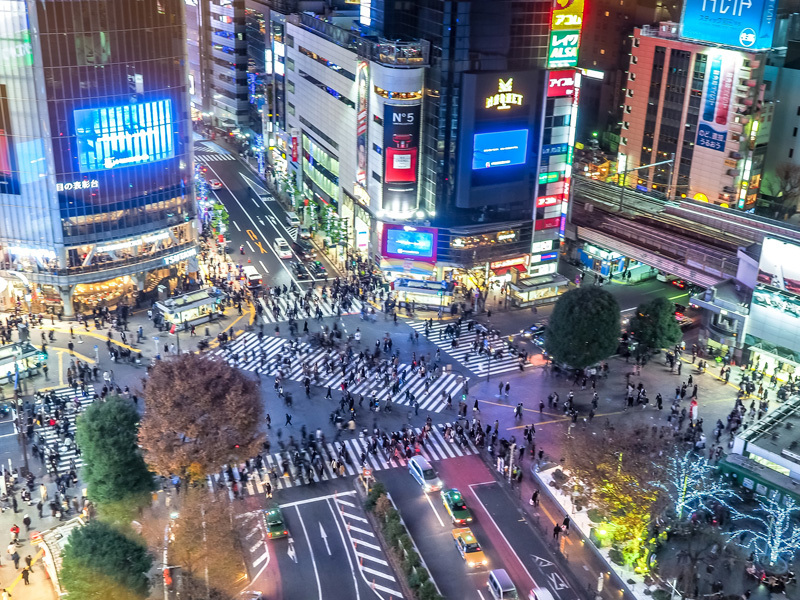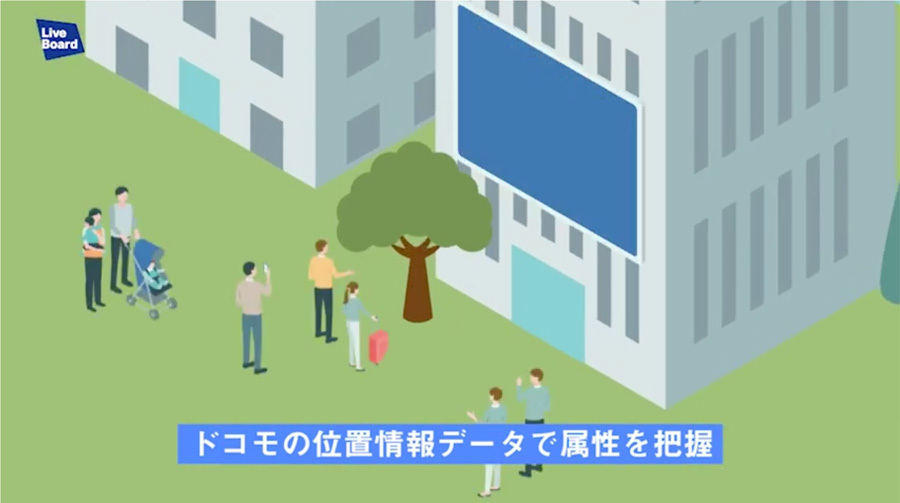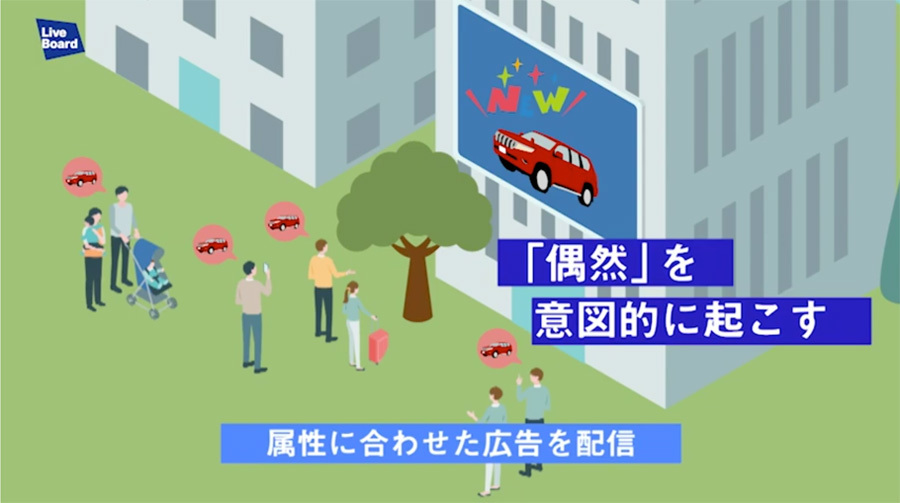Out-of-Home (OOH) advertising, which handles ad exposure outside the home, such as street billboards and train advertisements.
Because OOH effectiveness is difficult to measure, key metrics have traditionally focused on reach and circulation—essentially, "how many people could potentially be exposed." However, the actual purpose of OOH placements increasingly aims for effects that reach and circulation alone cannot explain, such as "creating a societal conversation" or "effectively changing consumer attitudes through that conversation."
Based on the hypothesis that OOH possesses this "societal impact effect," Dentsu Inc. launched an effectiveness verification project. We successfully visualized this "societal impact effect." From this, we developed a tool (beta version) enabling effective planning centered on attitude change. We aim to move forward toward a solution that can be utilized going forward.
Therefore, we have decided to launch a three-part series where various Dentsu Inc. planners involved in OOH planning gather to discuss OOH's "societal impact effect." We will explore the future of OOH media planning based on our effectiveness verification findings.
In Part 1, we asked them to discuss the significance of visualizing OOH's role, value, and effectiveness from both consumer and marketing planner perspectives.
【Participating Members】
Hiroshi Fukuda: Senior Solution Director, 3rd Integrated Solutions Bureau. Responsible for developing solutions across various media and serves as a driving force for the current OOH "Real-World Impact" project.
Keitaro Nagao: Business Producers Division 1. Since joining the company, he has worked as a Business Producer on media campaigns, including OOH, both domestically and internationally. After an overseas assignment, he now handles global brand strategy for clients.
Toshi Teramura: Marketing Planner, 3rd Integrated Solutions Bureau. Handles strategy formulation, media planning, and PDCA end-to-end. Has a proven track record of accompanying businesses through PDCA cycles across a wide range of stages and industries, from startups to national clients, driving their growth.
Ai Kuraishi: Solution Planner, 3rd Integrated Solutions Bureau. A planner skilled at devising communication strategies from thorough target insights and executing media plans & PDCA end-to-end.
Akane Furuike: After serving as a Planner in the OOH Division, she now works in the Data & Technology Center developing integrated on/off planning and effectiveness verification schemes utilizing the triple media of "TV × Digital × OOH."
What is the unique value of OOH?
Fukuda: Even before COVID, OOH was used by many companies. However, regarding its crucial effectiveness, it could only be measured by reach and circulation (the number and volume of people exposed to the ad). I constantly wondered, "Can't we visualize effectiveness from a different perspective?"
Personally, I feel OOH possesses a unique kind of "media pressure." Precisely because it's advertising simultaneously visible to countless eyes, once that "pressure" exceeds a certain threshold, it instantly becomes a talking point. I sense an effect that moves people, one that can't be simply expressed by terms like reach or circulation.
Kuraishi: While OOH is often evaluated alongside TV and digital, I feel TV commercials and digital ads are "passive media" for consumers, whereas OOH has an "active media" aspect—consumers actively look at it when it catches their interest. With its large visuals, powerful impact, and buzz potential, I think we need to think beyond treating it as just another traditional medium. Instead, we should explore how to combine it with TV and digital.
Fukuda: As an individual consumer, do you personally feel the unique impact of OOH?
Kuraishi: Jack advertisements that monopolize specific spaces definitely have a big impact. Plus, ads that match my mood and actions when I'm out and about stick with me more. For example, I still vividly remember an ad that resonated with my gloomy feelings during the pandemic when I absolutely had to go to work (laughs).
Furuike: Personally, when I'm too busy to watch TV, I rely on digital and OOH for information. I've learned about recent topics from weekly magazine insert ads, and now checking this season's new dramas via station wall ads has become a habit.
While OOH advertising serves various purposes, the most common client request is for "exposure." I believe one of OOH's core values is its ability to create a massive presence, much like a billboard ad.
Teramura: Speaking of presence, during the state of emergency, TV news constantly showed Shibuya deserted of people. The OOH ads visible in those shots left a huge impression. Even if you weren't physically there, just seeing them briefly on TV conveyed a "real presence and exposure" – that struck me as a major strength of OOH.
Nagao: When I was in Brazil, I was impressed by a sneaker brand's campaign. At the time, street graffiti had become a social issue in Brazil. The brand covered graffiti with sneaker illustrations, and only people who visited those specific locations could purchase the featured sneakers online. I believe OOH has the power to simultaneously generate buzz and address social issues.
Fukuda: Depending on the idea, it can create a presence and social relevance beyond mere exposure. This ability to engage with "worldly matters" is precisely the unique media value of OOH.

The "social impact effect" was proven over 20 years ago!
Fukuda: From your perspectives as consumers/planners, you likely intuitively feel OOH's "social impact effect" beyond mere reach and circulation. However, the challenge remains: "How do we actually visualize it?" What are your thoughts?
Nagao: Traditional metrics like reach tend to position OOH as a "supplementary medium" that complements appeals to specific areas or targets. That alone can be frustrating for those making proposals.
Teramura: I agree. Currently, scenarios where OOH is easy to propose are limited—like campaigns targeting specific areas or demographics, or those emphasizing creative execution. On the other hand, precisely because personal spaces increased during the pandemic, I sense more clients are recognizing the value in OOH as something that resonates with broader societal issues.
Fukuda: That's right. While many clients intuitively grasp the "social impact effect," it's hard to adopt OOH without quantifiable proof of that effect.
However, even in research published over 20 years ago by the Nikkei Advertising Research Institute (※1), findings reported that the "social phenomenon effect" (collective effect) – such as the sense of buzz or product awareness generated through mass advertising – influences individual attitude change.
※1=Source: Mochizuki, Y., & Nishina, S. (2000). "Verification and Development of the 'Group Effect' of Mass Media Advertising." Nikkei Advertising Research Institute 34(4), 16-22, 2000-08
We thought that updating this research to reflect the realities of consumers and the media environment in 2021 might allow us to prove the "social phenomenon effect." Furthermore, by leveraging the data infrastructure of LIVE BOARD(※2) developed by NTT DOCOMO and Dentsu Inc., we believed we could verify the effect more clearly. This led to the launch of the "Social Phenomenon Effect" verification project.
※2=LIVE BOARD
A new company established by NTT Docomo and Dentsu Inc. to operate a digital OOH advertising delivery platform and sell advertising space. It enables OOH ad delivery based on impressions (ad viewers) and user attributes, making it possible to verify OOH advertising effectiveness and ROI. It owns a networked digital signage system called "LIVE BOARD" nationwide.
Can OOH's "worldly impact" truly be visualized?
Furuike: Our case studies show that people perceive something as "trending" more readily as contact points increase—whether TV, digital, or OOH. It's similar to seeing a colleague always wear the same outfit at work versus seeing many people wearing the same outfit on the street. The latter creates a stronger sense of "it's popular," right?
I believe that as the number of contacts and contact points increases, it fosters the feeling that "this product is currently a hot topic in society."
Teramura: Thinking about it that way, LIVE BOARD—which allows selecting the optimal location and timing from multiple OOH slots for ad delivery—offers opportunities to be seen in various places. That makes it an OOH medium where we can expect greater "socialization" of the product, right?
Fukuda: Recently, we're seeing more cases where reach is achieved through TV and digital, yet awareness doesn't increase. One contributing factor might be that "information is overly personalized." In that sense, OOH is a medium where you can tangibly feel that an unspecified number of people are seeing it, so it may inherently possess characteristics that make it easier to generate that 'it's happening everywhere' effect.
Kuraishi: Regarding creating a sense of shared societal relevance, I also think the ability to deliver brand messages is significant. By overlaying messages onto the imagery consumers associate with a city, more powerful content is created. This is a unique media value of OOH that's difficult to achieve solely through TV or digital.
Fukuda: That's certainly true. When OOH advertising expressions combine with the unique symbols inherent to a city like Shibuya, OOH becomes even more impactful.
Based on our discussion so far, I believe that if we can visualize and substantiate this "societal impact effect," the significance of OOH will change dramatically. Visualizing the effect would also enable us to propose media planning that works backward from the client's goals.
Teramura: In actual client cases using LIVE BOARD, we've successfully visualized key brand strategy metrics like "awareness" and "top-of-mind recall." For a subscription service facing the challenge of acquiring new demographics, running the same creative assets as TV commercials on LIVE BOARD led to results showing improved awareness retention and increased interest.
Furuike: Particularly for driving foot traffic to physical stores, we can now measure post-visit purchases—something traditionally difficult to track—while maintaining personal information protection. For one restaurant chain, promoting a new product via LIVE BOARD allowed us to analyze the characteristics of customers who purchased specifically because they were exposed to LIVE BOARD. Examining this data through various lenses—demographics, purchase frequency, average spend—made it easier to strategize for future campaigns.
Fukuda: So there's already proven results in visualizing the "world impact" of OOH to some extent. Next time, I'd like to delve deeper into the survey results utilizing LIVE BOARD's verification platform.















